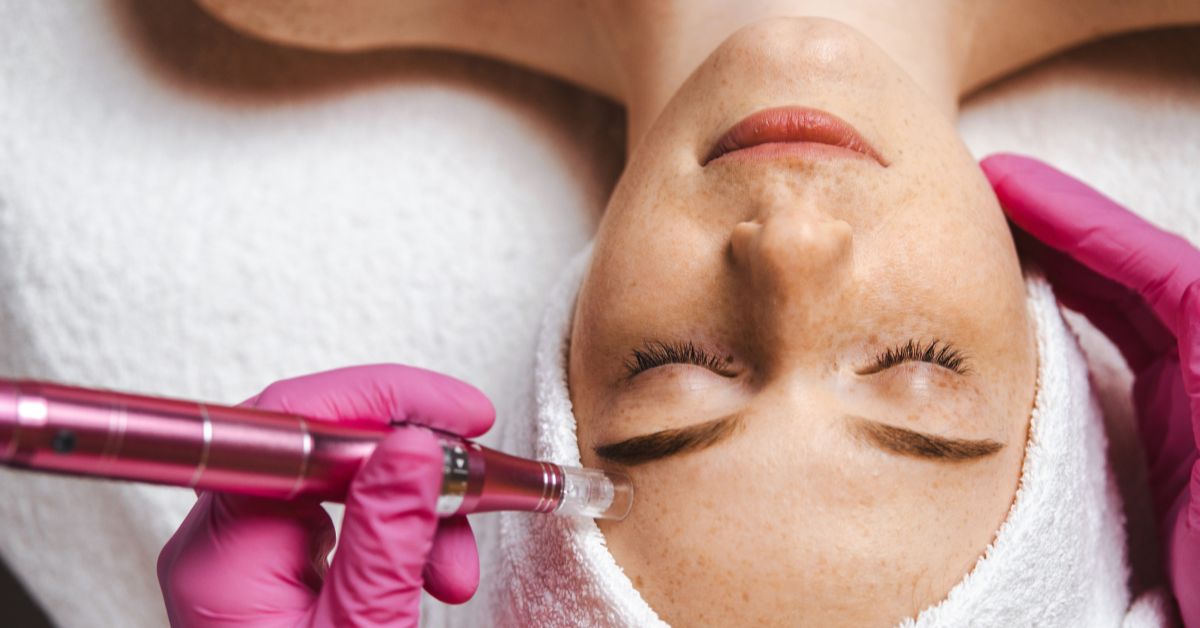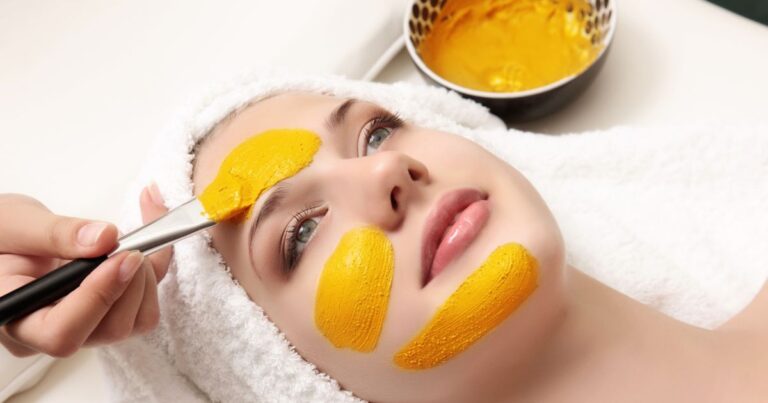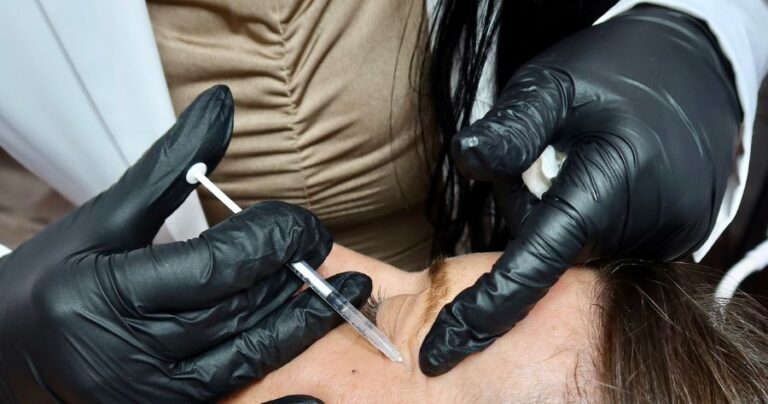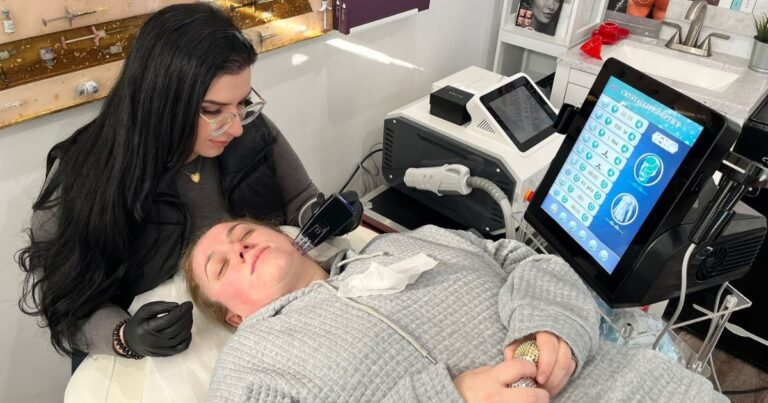Microneedling has become one of the most popular skin treatments for a reason—it works. Whether you’re dealing with acne scars, uneven texture, or early signs of aging, this simple procedure helps your skin repair itself from the inside out.
It’s not about changing your face—it’s about giving your skin a chance to rebuild, smooth out, and glow naturally. Instead of covering up issues with layers of product, micro needling encourages your body to fix them on its own by boosting collagen where it’s needed most.
But here’s the key: results don’t just depend on the treatment—they depend on how you prepare and what you do afterward. So, before you book your first session, it helps to know exactly what microneedling does, what you’ll feel during and after the procedure, and how to care for your skin to get the best outcome.
Let’s break it all down, starting with what micro needling really is and why so many people swear by it.
What Is Microneedling?
Microneedling is a cosmetic treatment that uses tiny, controlled punctures to stimulate your skin’s natural repair process. It may sound intense, but it’s actually a gentle and minimally invasive way to improve your skin’s appearance and feel over time.
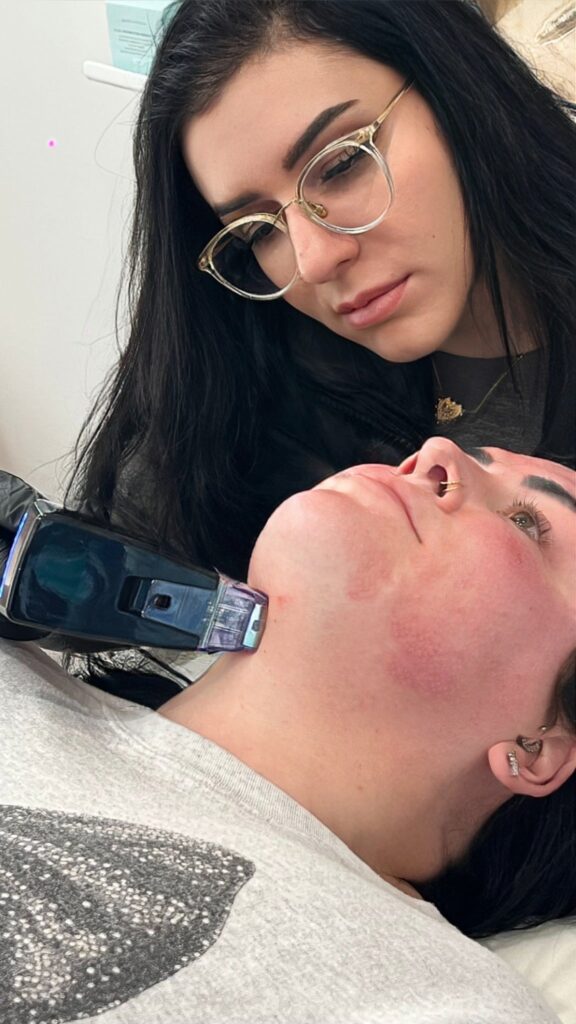
How the Procedure Works
The treatment involves a device covered in fine, sterile needles. As the device moves across your skin, it creates tiny, controlled injuries—called micro-injuries. These micro-injuries don’t cause visible damage but are just enough to trigger your body’s natural healing process. In response, your skin ramps up collagen and elastin production—the proteins that keep your skin firm, smooth, and youthful.
That’s why microneedling is often referred to as “collagen induction therapy.” It encourages your body to rebuild the skin from within, rather than simply treating the surface.
There are two main tools used:
- Dermaroller: A handheld roller with microneedles that you manually move across the skin. This tool is often used at home but usually produces less dramatic results.
- Microneedling Pen (or device): A powered pen-like device that delivers vertical needle movements at a consistent depth and speed. This is what most professionals use, as it’s more precise and customizable based on skin needs.
The depth of the needles can be adjusted depending on the area being treated—for example, delicate areas like under the eyes use shorter needles, while deeper scars may require slightly longer ones. Most sessions last about 30 to 45 minutes, depending on the treatment area.
What It Treats
Microneedling isn’t a one-trick treatment. It’s used for a wide range of skin concerns:
- Fine Lines and Wrinkles
The collagen boost helps plump the skin, softening the look of fine lines and making the skin appear smoother and tighter over time. - Acne Scars and Enlarged Pores
Microneedling helps break down scar tissue and encourages new, healthy skin to form. It also tightens the skin around pores, making them look smaller and less noticeable. - Rough or Uneven Skin Texture
If your skin feels bumpy or dull, microneedling can smooth things out by increasing cell turnover and encouraging fresher skin to rise to the surface. - Stretch Marks and Hyperpigmentation
The treatment can improve the look of stretch marks by thickening the skin and evening out tone. It also helps fade dark spots and discoloration, especially when combined with targeted serums. - Sun Damage and Age Spots
By promoting faster skin regeneration, microneedling helps fade the signs of sun exposure and refresh sun-damaged areas. - Thinning Skin or Laxity
For mature skin, microneedling supports firmer texture and better elasticity by rebuilding structural proteins lost over time.
Top Benefits of Microneedling
Microneedling is more than a trend, but a proven treatment with real science behind it. It doesn’t just resurface your skin, it helps rebuild it from within. Below are the top benefits that make this treatment a favorite among both professionals and clients.
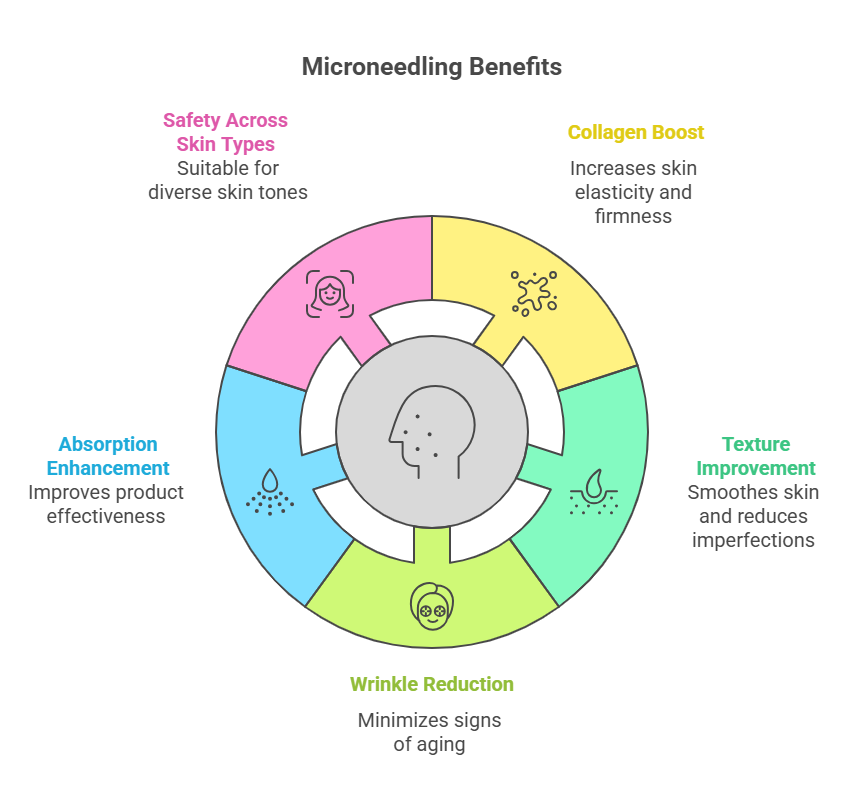
Boosts Collagen and Elastin Production
Your skin’s structure depends on two key proteins: collagen and elastin. Collagen gives it strength and firmness, while elastin keeps it flexible. As you age, both levels drop, and that’s when wrinkles, sagging, and dullness show up.
Microneedling helps reverse that. Those tiny needle punctures trick your skin into thinking it’s injured. In response, your body sends collagen-building signals to repair the area. Over time, this leads to smoother, tighter, and healthier-looking skin, without changing your natural features.
Improves Skin Texture and Reduces Scarring
If your skin feels bumpy or uneven, micro needling can help resurface it. The process encourages fresh skin cells to replace older, damaged ones. For acne scars, especially, micro needling breaks up tough scar tissue and promotes new collagen in its place.
It also helps fill in pitted areas, softening the appearance of old breakouts. Because it clears the way for better cell turnover, it can help reduce clogged pores and improve the skin’s appearance over time.
Minimizes Fine Lines and Wrinkles
One of the biggest reasons people try microneedling is to smooth out early signs of aging. While it won’t freeze your face or fill in deep lines like Botox or filler, it does gradually fade fine lines and soft creases, especially around the mouth, eyes, and forehead.
The results build slowly, but they look natural because they come from your own skin improving itself.
Enhances Product Absorption
Microneedling opens up tiny channels in your skin for a short time. During that window, your skin becomes more absorbent, meaning it can soak in serums and active ingredients much more deeply.
This gives your products a real chance to work. After treatment, most pros recommend using simple, hydrating serums like hyaluronic acid or peptides. Vitamin C can also help, but only if your skin can tolerate it, as some people may feel mild stinging after needling.
Avoid retinol or acids immediately after, since they can be too harsh on freshly treated skin.
Safe for Most Skin Types and Tones
Unlike some lasers or peels, which can cause discoloration, especially on deeper skin tone,s micro needling is generally safe for all. It doesn’t use heat or harsh chemicals, which reduces the risk of triggering hyperpigmentation.
This makes it a smart option for people with melanin-rich skin who want results without the side effects of more aggressive treatments.
Bonus: Can Be Combined With Other Treatments
Microneedling works well on its own, but it can also be paired with other options like PRP (Platelet-Rich Plasma) or exosomes to speed up healing and boost results. Some clinics offer combo treatments for deeper repair or faster glow-ups before big events.
What to Expect During and After a Microneedling Session
Microneedling is a process, not a quick fix, but that’s what makes the results so long-lasting and natural.
Knowing what to expect can help you feel more confident walking into your first micro needling appointment. From how it feels to how long it takes to heal, here’s a clear breakdown of the entire experience.
During the Procedure
Before the procedure begins, your provider will apply a numbing cream to reduce any discomfort. Once your skin is numb—usually after 20 to 30 minutes—the session begins.
They’ll use a microneedling pen or device to move evenly across your face or targeted area. You might feel light pressure, a tingling sensation, or a slight scratchy feeling. Most people say it’s totally manageable, especially with numbing.
The whole process takes 30 to 45 minutes, depending on the size of the area treated. If you’re treating just the face, it’s usually quicker than if you’re also treating the neck or stretch marks elsewhere.
Immediately After Treatment
Right after the session, your skin will look red, like a mild sunburn. It may also feel warm, tight, or slightly swollen. Some people notice pinpoint bleeding or tiny scabs the next day, which is normal.
These effects typically fade within 24 to 48 hours, and many people are back to their usual routine within a day or two.
Recovery Timeline
Day 1–2:
- Redness and sensitivity
- Skin may feel tight, warm, or slightly swollen
- Avoid makeup, sweating, and sun exposure
Day 3–5:
- Flaking or peeling may begin as dead skin sheds
- Keep skin hydrated and avoid picking or scrubbing
Day 6–7 and beyond:
- Skin looks clearer, smoother, and more even
- Glow becomes more noticeable with each session
Some results like improved texture or smaller pores, can show up within a week. However, deeper changes, like collagen growth and scar fading, take about 4 to 6 weeks to develop and get better with multiple sessions spaced 4 to 6 weeks apart.
How to Prepare for Microneedling
Getting great results doesn’t start in the treatment chair—it starts before. How you prepare in the days leading up to your microneedling session can make a big difference in how your skin responds and heals. Here’s what to do and what to avoid.
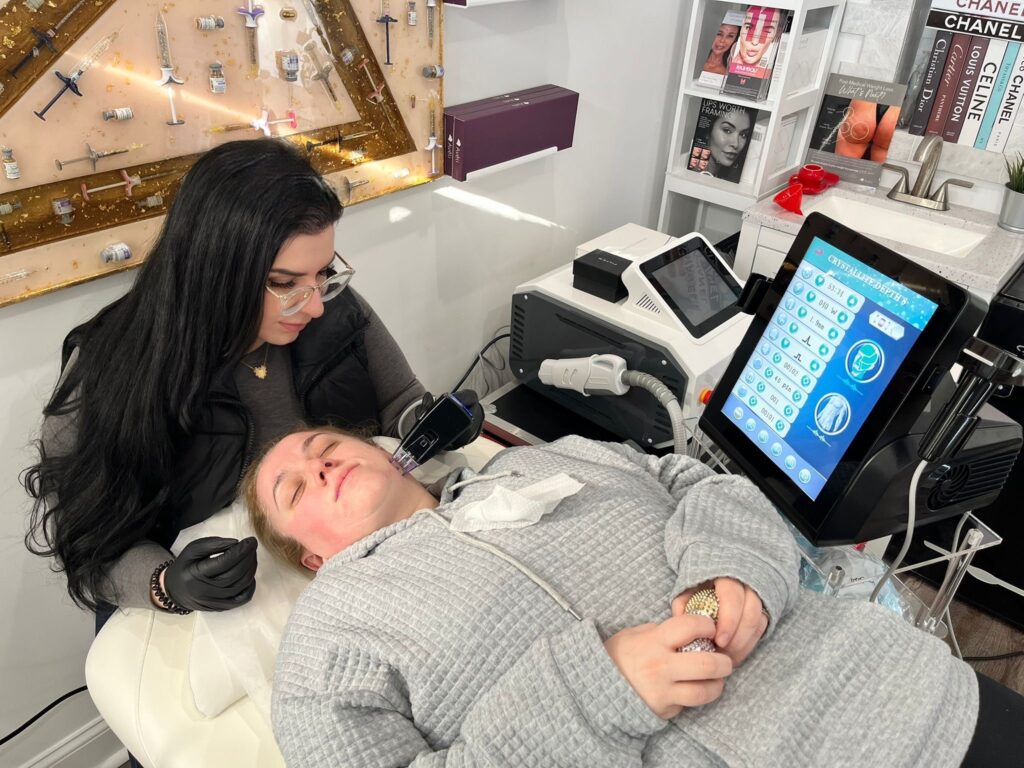
Pre-Treatment Guidelines
1. Stop Using Harsh Products
Avoid retinol, exfoliants, and acid-based serums (like glycolic or salicylic acid) for at least 3–5 days before your appointment. These can make your skin more sensitive and increase irritation during the session.
2. Stay Out of the Sun
Don’t show up with a sunburn or tan. Sun exposure can weaken your skin barrier and make treatment less effective—or worse, lead to damage. Use SPF every day leading up to your appointment.
3. Skip Blood Thinners if Cleared by Your Provider
Medications or supplements like aspirin, fish oil, or vitamin E can increase the chance of pinpoint bleeding. Always check with your provider before stopping anything, especially prescriptions.
4. Avoid Alcohol and Caffeine
Try to skip alcohol and heavy caffeine 24 hours before your session. Both can increase inflammation and sensitivity.
5. Come With Clean Skin
Arrive with a fresh face—no makeup, lotions, or sunscreen. Your provider needs a clean surface to work on for the best and safest result.
Questions to Ask Your Provider
Don’t be afraid to ask a few smart questions. A skilled provider will welcome them:
- What device do you use?
Look for a medical-grade microneedling pen—not a basic dermaroller. - How deep will the needles go?
Depths can vary based on your skin concern. Acne scars may need deeper treatment than light texture issues. - What should I expect afterward?
A clear answer shows they’re honest about recovery and care, not overselling results. - How do you handle side effects or reactions?
Even though microneedling is low-risk, it’s good to know you’re in capable hands if something unexpected happens.
Preparation is simple, but it matters. Get these steps right, and you’ll set yourself up for better healing and smoother results.
Post-Treatment Care Tips
What you do after microneedling matters just as much as the treatment itself. Your skin is more open and sensitive during this time, which means it’s also more responsive—to both the good and the bad. A simple, gentle routine helps your skin heal faster and get the best results.
What to Avoid
1. No Makeup for 24–48 Hours
Give your skin a break. Applying makeup too soon can clog healing pores and cause breakouts or irritation. Let your skin breathe.
2. Avoid Sweating and Heat
Skip workouts, saunas, and hot showers for a day or two. Heat and sweat can irritate treated skin and increase redness or swelling.
3. Stay Out of the Sun
Freshly treated skin is more prone to sun damage. Avoid direct sunlight for at least a week and always wear a mineral-based SPF when you go outside.
4. Don’t Pick or Exfoliate
As your skin starts to peel or flake, it can be tempting to scrub or pick. Don’t. Let it shed naturally to avoid scarring or delay healing.
What to Do
1. Use Gentle, Hydrating Products
Stick to basics: a mild cleanser, a fragrance-free moisturizer, and lots of hydration. Look for ingredients like hyaluronic acid, ceramides, or aloe vera to soothe and repair.
2. Apply Sunscreen Daily
Even if you’re indoors most of the time, sunscreen protects your healing skin from any UV exposure. Use SPF 30 or higher and reapply if you go outside.
3. Consider Healing Serums
If your provider recommends it, use serums like peptides or growth factors to support repair. Skip anything harsh like retinol or acids for at least a week.
4. Stay Hydrated and Eat Well
Good skin starts from the inside too. Drink plenty of water and eat whole foods rich in vitamins A, C, and E to support your skin’s recovery.
Keep things simple and let your skin do the work. Most irritation clears up in a couple of days, and with good care, you’ll start to notice that post-treatment glow sooner.
Who Should Avoid Microneedling?
Microneedling is safe for most people, but it’s not for everyone. Certain skin conditions and health issues can make the treatment risky or less effective. Knowing where you stand can help you avoid problems and keep your skin healthy.
Skin Conditions That Need Caution
- Active Acne or Skin Infections
If you have breakouts, cold sores, or any infection on your face, wait until it clears up. Microneedling can spread bacteria and make things worse.
- Rosacea or Eczema
These conditions make your skin more reactive. The treatment could trigger a flare-up or cause too much inflammation. Always check with a dermatologist first.
- Keloid Scarring
If your skin tends to form raised scars, microneedling might not be a good idea. While rare, it can increase the risk of more scarring in people with that tendency.
Health or Medical Considerations
- Blood Clotting Disorders or Blood Thinners
If you’re taking medication that affects blood clotting or have a condition that impacts healing, micro needling could cause more bleeding or slower recovery. Always consult your doctor.
- Pregnancy and Breastfeeding
Although microneedling is generally safe, many providers recommend holding off during pregnancy and early breastfeeding as a precaution, especially if numbing agents or add-on treatments are involved.
- Recent Skin Procedures
If you’ve recently had Botox, chemical peels, or laser treatments, wait at least 2 weeks—or follow your provider’s advice. Layering treatments too closely can irritate your skin.
When in Doubt, Ask First
The safest way to know if micro needling is right for you is to talk to a qualified provider. A quick consultation can help spot potential issues and suggest alternatives if needed.
Conclusion: Is Microneedling Worth It?
Microneedling is one of those rare treatments that bridges science and simplicity. It doesn’t rely on trends or gimmicks—just your body’s ability to heal and rebuild. If you’re looking for a natural way to improve skin texture, fade scars, and boost overall skin health without harsh chemicals or downtime, this treatment is worth considering.
But here’s the part that matters most: results take commitment. One session might give you a glow, but consistent care—before and after—is what leads to lasting change. That means showing up prepared, following post-treatment guidelines, and trusting the process.
And remember, you don’t have to figure it all out on your own. Talk to a licensed provider. Ask questions. Be honest about your skin history and goals. The right professional will guide you, personalize the treatment to your needs, and help you build a plan that fits your skin, not someone else’s.
So, if you’re ready to invest in real skin change—not just cover-ups—micro needling could be your next best move.
